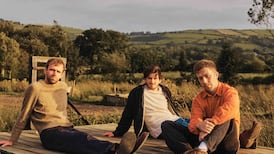The Berlin nightclub Berghain occupies an almost mythical space in club culture. But it is real, still going and the subject of a creative exploration by Liam Cagney, a writer and musicologist who lives in the city.
Cagney grew up in Portnoo, Co Donegal, “sharing a bedroom with an older brother who was listening to The Orb, Orbital, Plastikman and all that stuff. I was just a little kid but my head was being filled with that stuff,” he says. “I took that base knowledge for granted.”
He’s writing a book, provisionally called Berghain Nights, that’s due to be published next year. “It’s a personal journey through techno and club culture. It’s about me really trying to make sense of my experience going clubbing in Berlin, and dramatising those experiences,” he says. “I wanted to write about techno because I just got fascinated with it, and how strange and enriching the experiences I had were. I didn’t want to write about it in a journalistic, surveying way … I wanted to centre one person’s experience – and since I happen to be living in my body, I decided to use my own.”
Cagney had been visiting Berlin on and off since 2006, and he lived there briefly in 2010. “In 2016 I kind of cashed out of Ireland, like a lot of people,” he says. “I felt at a loose end. I just moved over because I knew some people in Berlin. I knew it was relatively easy to live here then and get by on freelancing. I ended up living in a strange squat on the outskirts of the city and I ended up going clubbing again in Berghain. I hadn’t been in 10 years, and that night I had a really transformative experience.” That was in August 2016, at a Berghain night focusing on Ostgut Ton, its record label, and resident DJs.
READ MORE
Berghain began as a club night called Snax, in an imposing 1940s air-raid shelter known as Bunker that hosted hard-core techno parties in the 1990s. (Cinephiles and fans of Architectural Digest will recognise its modern penthouse as the home of Lydia Tár, Cate Blanchett’s character in Todd Field’s film about the fictional conductor.)
Another venue followed, called Osgut, and then the current building, a former power plant that incorporates both Berghain and the house-music-focused Panorama Bar. For its main weekend club night, the building (which was designated a cultural institution in 2016) opens on Saturday night and doesn’t close until Monday morning. Photography is banned, there are no mirrors or other reflective surfaces, and time can do strange things, both evaporating and expanding.
Cagney had intended to write a novel, but “I deviated,” he says, “and then the deviation became the main thing.” Last last year Cambridge University Press published his book Gérard Grisey and Spectral Music: Composition in the Information Age. Cagney’s Substack, Berlin Waveforms, which documents experiences at Berghain, is a must-read for those interested in expert appraisals of a given party and the track selection of Berghain DJs.
“I hope the critical stuff gives value to people, as I have some training as a musicologist. But ultimately it’s about the human experience. Berghain is a place that reflects you back to yourself. If you go into this place where the normal rules do not apply – there are no windows; clock time can disappear; you’re basically allowed to do whatever you want, with consent – you’re asking yourself, ‘What do I really want? Who am I?’ People have a space to explore themselves there.”
Berlin clubs have been closing down since the pandemic. Last month Watergate announced it was shutting after 22 years. In August Renate announced its closure after 18. A recent rave protest, supported by Berlin Club Commission, took place against the planned extension of a motorway in the city that threatens numerous clubs.
“Gentrification has been slowly creeping in the past 15 years or so, and since the pandemic it’s really pronounced,” Cagney says. “Berlin is still, relative to other places, very liberal and attracts people who don’t feel they fit in elsewhere. But it’s got a housing crisis comparable to those in Dublin and other places in Ireland, which means [that for] freelancers, queer people, artists, it’s much less affordable … I do get reminded of London more and more over here now ... That feeling is creeping in.”
Tension in the city about the German government’s support of Israel, with media condemnation of peaceful protesters, accusations of censorship and police violence, have also changed the atmosphere. “This is another really important thing to talk about,” Cagney says. “I was always told – and believed, due to things I read – that Germany is a model of historical memory and centring [its crimes] in the national narrative. That always impressed me, having lived in England. But in the past year that narrative has come crashing down … There are serious questions around the cancellation of events involving Palestinian and pro-Palestinian artists in Berlin.”
On Sundays, if Cagney isn’t at Berghain, he often goes deep into a forest in the city. It’s not as contrasting an experience as you might think. “Very often I go clubbing alone,” he says. “I go clubbing sober – I don’t drink or anything. My attitude towards it that is we need to reframe how we think about clubbing. There are connotations from the 1990s, scaremongering that it’s just about drugs and hedonism. I’m sure for a lot of people it’s about that, but a lot of it isn’t … If I go into a dark space and listen to techno for two or three hours, it’s kind of like a meditation. I feel refreshed. It helps me come back to myself.”


















